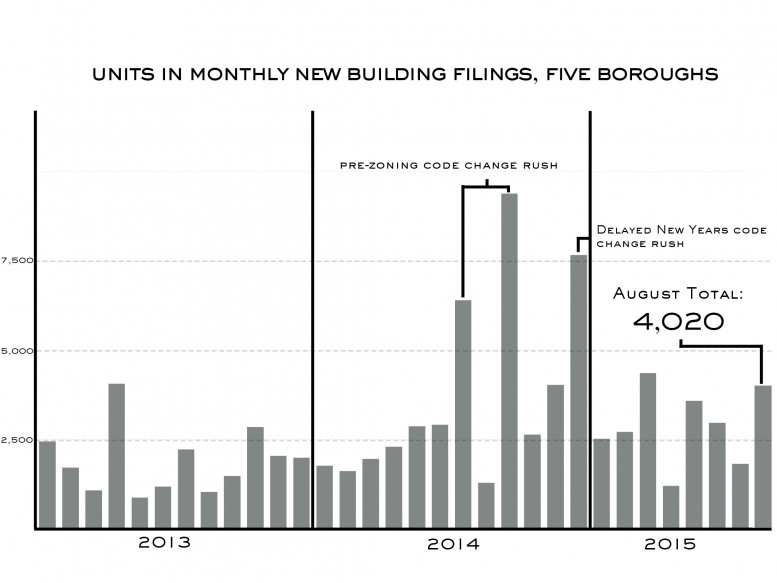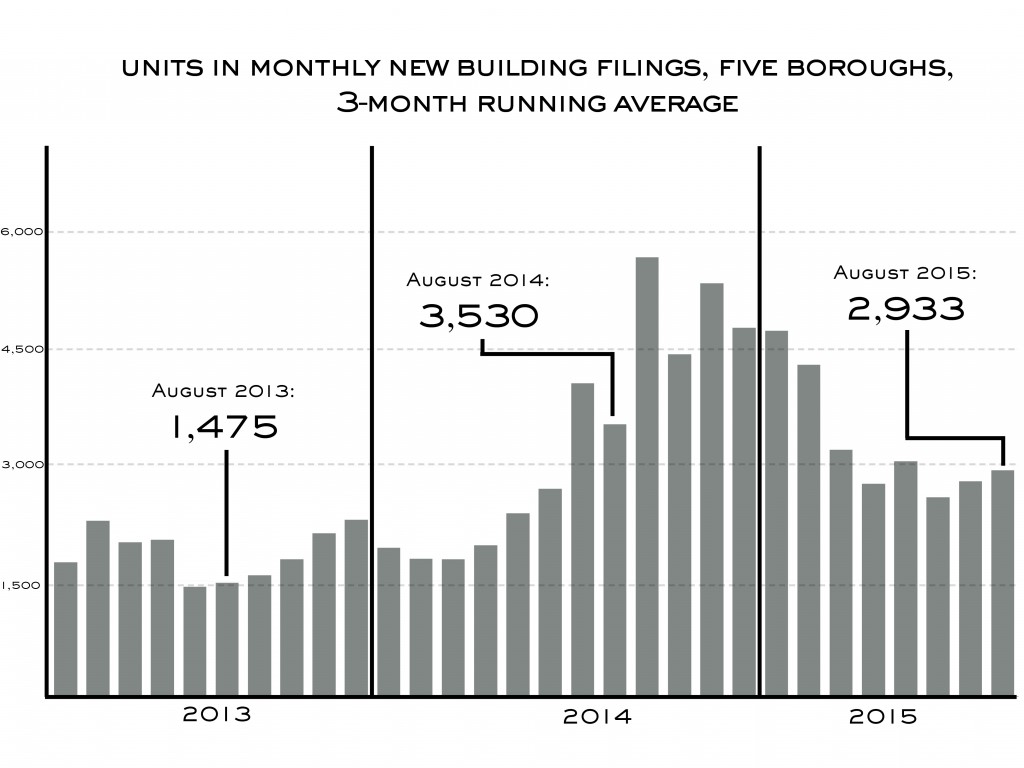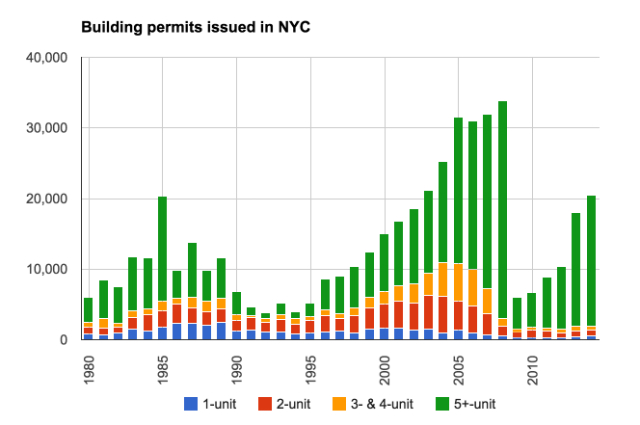The latest numbers from the DOB show a major increase in year-over-year filings for August, and 2015’s running total has once again surpassed 2014’s, after falling behind in July. In terms of raw numbers, New York City saw new building applications submitted for a total of 4,020 units this past August, more than tripling last year’s figure of 1,281, and putting 2015’s running total of new units at 23,165 as of 8/31, ahead of 2014’s 21,099.
July’s data had appeared foreboding, with the number of units entering the development pipeline across the five boroughs decreasing over 70% year-over-year, falling from 6,403 in 2014 to 1,815 this year. But last year’s impressive number was partially due to anticipated changes in the zoning code and nerves over impending changes to 421-a, which resulted in even larger waves of new building applications in September and December.
Taking a look at broader year-over-year trends, 2015 held up relatively strong compared to last year’s numbers through June, significantly besting 2014’s totals in January, February, March, and May. June saw only a slight increase, and April’s numbers decreased, while July’s figures plummeted. 2015’s 3-month June/July/August total came to 8,799 units, falling short of 2014’s figure of 10,590, but still holding high above 2013’s paltry total of 4,425.
The push in applications last year was largely due to anticipated changes to New York’s zoning code, and adjustments to qualifications for 421-a tax abatements. Those administrative changes are obvious in the data, with both September and December of 2014 standing head and shoulders above any other recent months in terms of filings (coming in at 9,390 and 7,864 units, respectively).
Last July’s total count of 6,403 submitted units may have also been inflated by anticipatory filings ahead of building code changes, which were initially expected last September, before being pushed to New Years.
Besides July, September, and December of 2014, no other month in either 2013 or 2015 had over 6,000 applications, with 2013’s April high of 4,058 units coming in just below March 2015’s total of 4,353 units. The only other month with over 4,000 submitted units was November of 2014, which is now joined by this past August.
Approximately one year after some of the most impressive filing frenzies in New York’s history, things appear to be slowing down, at least on paper. But this may not necessarily reflect an actual slowdown in new construction. Since many of the filings from late 2014 were essentially “dummy” applications, a larger percentage of those projects than normal may be awaiting actual permits and construction activity, while those already in the ground in anticipation of 421-a changes could potentially leave their foundations in a zombified state.
Last year, submissions for new units almost doubled from 2013’s total of 22,915, increasing to 44,817. With this year already at 23,165 new units, 2015 is on track to add something in between those two numbers, and has already surpassed the entirety of 2013.
Breaking the year-over-year numbers down by borough, Manhattan has seen the only decrease so far, with the first eight months of 2015 totaling 3,863 new units, down from 6,646 in 2014. Brooklyn saw a slight increase in filings, from 7,275 to 7,509, and so did Staten Island, where numbers rose from 491 to 506. The largest jumps in activity were in Queens, where numbers boomed from 4,959 to 7,386, while the Bronx saw applications for new units more than double, from 1,728 to 3,901.
The numbers for the rest of 2015 will be important in measuring whether the post-2008 development cycle peaked in late 2014 or not. While the uptick in August data is impressive, the steep drop between this July and last seems likely to be echoed by similar contractions in September, November, and December (those three months alone accounted for 21,283 units last year, or nearly the equivalent of the entire total for 2013).
Even if momentum continues to decrease, that probably will not translate into a crash. The fundamentals behind urban growth have changed substantially over the past decade, even since the 2008 financial crisis, with the five boroughs now ranking among the fastest-growing large cities in the country. And while politicians seem incapable of acknowledging, managing, or responding to this growth, it should have the positive side effect of ensuring New York City maintains a relatively healthy construction industry in the near to medium-future, even if the monthly numbers this autumn fall short of the figures from late last year.
Of course, even if all the permitted units are built, developers are not building nearly enough housing to cope with the city’s population growth. With an average increase of over 70,000 people a year since the 2010 Census, New York needs to grow its housing stock by at least 50,000 units a year to prevent continued price spirals.
Continued administrative incompetence has disenfranchised much of New York’s middle class from the opportunity afforded by new development. With the disintegration of two, three, and four-family housing in the outer boroughs following the Bloomberg downzonings, an immense amount of potential middle-class wealth (that would normally be harvested through redevelopment and new construction at a time like today) has been vaporized. This also has the side-effect of eliminating the small-scale new market-rate construction that is legitimately affordable without the need for “affordable” lottery allocations.
While the easiest target for critics of the affordability crisis may be the supertalls of 57th Street, the real issues are inadequate zoning and the need for property tax reform. The former issue has hit New York’s middle and working classes particularly hard, pushing them further and further from the area’s urban core, while the latter problem awards wealthy owners of co-ops and condos of buildings built before 1974 with tax-rates set to the same levels as those on rent-regulated buildings.
Unfortunately there is still much more to be done that remains unaddressed. While August’s numbers are better than July’s, the amount of housing entering the pipeline should still be far higher than it currently is. But at the very least, the latest data hopefully proves that the housing market remains resilient even in the face of the changes (for better or worse) enacted so far by the De Blasio administration.
Subscribe to YIMBY’s daily e-mail
Follow YIMBYgram for real-time photo updates
Like YIMBY on Facebook
Follow YIMBY’s Twitter for the latest in YIMBYnews




What’s the difference between Yimby’s DOB calculation and the Census permit survey? Such a striking difference this year and last.